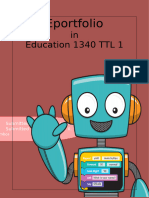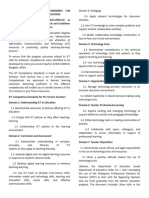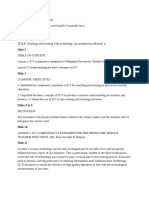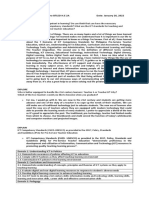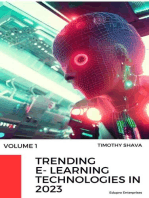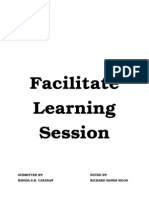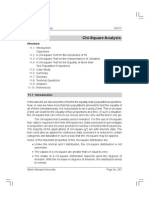0 ratings0% found this document useful (0 votes)
14 viewsTTL Midterm Reviewer - 022428
TTL Midterm Reviewer - 022428
Uploaded by
rehanahamsaCopyright:
© All Rights Reserved
Available Formats
Download as DOCX, PDF, TXT or read online from Scribd
TTL Midterm Reviewer - 022428
TTL Midterm Reviewer - 022428
Uploaded by
rehanahamsa0 ratings0% found this document useful (0 votes)
14 views7 pagesOriginal Title
TTL-Midterm-Reviewer_022428
Copyright
© © All Rights Reserved
Available Formats
DOCX, PDF, TXT or read online from Scribd
Share this document
Did you find this document useful?
Is this content inappropriate?
Copyright:
© All Rights Reserved
Available Formats
Download as DOCX, PDF, TXT or read online from Scribd
Download as docx, pdf, or txt
0 ratings0% found this document useful (0 votes)
14 views7 pagesTTL Midterm Reviewer - 022428
TTL Midterm Reviewer - 022428
Uploaded by
rehanahamsaCopyright:
© All Rights Reserved
Available Formats
Download as DOCX, PDF, TXT or read online from Scribd
Download as docx, pdf, or txt
You are on page 1of 7
TECHNOLOGY FOR TEACHING AND LEARNING 4.
3 Demonstrate proficiency in the use of technology
tools to support teaching and learning
Lesson 1 DOMAIN 5: ORGANIZATION AND ADMINISTRATION
ICT COMPETENCY STANDARDS (CHED-UNESCO) - as 5.1 manage technology-assisted instruction in an
inclusive classroom environment
provided in the 2017, Policy, Standards and Guidelines
5.2 Exhibit leadership in shared decision-making using
(PSG) for Pre-Service Teacher Education.
technology tools
DOMAIN 1: UNDERSTANDING ICT IN EDUCATION
1.1 Demonstrate awareness of policies affecting ICT in DOMAIN 6: TEACHER PROFESSIONAL LEARNING
education 6.1 Explore existing and emerging technology to
acquire additional content and pedagogical
1.2 Comply with ICT policies as they affect teaching-
knowledge
learning
6.2 Utilize technology tools in creating communities of
1.3 Contextualize ICT policies to the learning
practice
environment 6.3 Collaborate with peers, colleagues and
ICT POLICIES - Every school can have different ICT stakeholders to access information in support of
policies. While there are overarching national and professional learning
international guidelines, individual schools often tailor
their ICT policies to fit their specific needs and DOMAIN 7: TEACHER DISPOSITION
contexts. 7.1 Demonstrate social, ethical, and legal
responsibility in the use of technology tools and
Data Privacy Policies: Ensuring the protection of resources
students’ personal information in compliance with 7.2 Show positive attitude towards the use of
laws like the Data Privacy Act. technology tools
Cybersecurity Policies: Measures to protect
educational institutions from cyber threats and ensure ISTE National Educational Technology Standards for
Teachers and Students
safe online environments for students and staff.
ISTE National Educational Technology Standards for
DOMAIN 2: CURRICULUM AND ASSESSMENT Teachers (NETS’T) include five standards
2.1 Demonstrate understanding of concepts,
principles and theories of ICT systems as they apply to Technology Operations and Concepts- Teachers must
teaching-learning understand how technology works. This includes
2.2 Evaluate digital and non-digital learning resources knowing how to use computers, software, and other
in response to student's diverse needs digital tools.
2.3 Develop digital learning resources to enhance
teaching-learning Planning and Designing Learning Environments and
2.4 Use ICT tools to develop 21st century skills: Experiences - Teachers should use technology to
information media and technology skills, learning and create effective learning experiences.
innovation skills, career skills and effective
Assessment and Evaluation - Teachers use technology
communication skills
to assess and evaluate student learning.
DOMAIN 3: PEDAGOGY Productivity and Professional Practice - Teachers
3.1 Apply relevant technology tools for classroom
should engage in continuous professional
activities
development using technology.
3.2 Use ICT knowledge to solve complex problems and
support student collaborative activities. Social, Ethical, Legal, and Human Issues - Teachers
3.3 Model collaborative knowledge construction in need to understand the broader issues related to
face to face and virtual environments technology, such as ensuring that students use the
internet safely and responsibly.
DOMAIN 4: TECHNOLOGY TOOLS
4.1 Demonstrate competence in the technical ISTE National Educational Technology Standards for
operations of technology tools and systems as they Students (NETS’S)
apply to teaching and learning Creativity and Innovation - Students should use
4.2 Use technology tools to create new learning technology to express their creativity.
opportunities to support community of learners
Communication and Collaboration - Students should SOFTWARE - refers to program control instructions
use digital tools to work together and communicate. and accompanying documentation; Stored on disks or
tapes when not being used in the computer. By
Research and Information Fluency – Students should extension, the term Refers to any audiovisual
be able to find and use information effectively. materials (Smaldino, 2005)
Critical Thinking, Problem Solving, and Decision MULTIMEDIA - is a sequential or simultaneous use of
Making - Students should use technology to solve a variety of media formats in a given Presentation or
problems and make decisions. self-study program (Smaldino, 2005)
Digital Citizenship - Students should learn to use INTERNET - is a massive network of networks, a
technology responsibly. networking infrastructure. It connects Millions of
Technology Operations and Concepts - Students need computers together globally, forming a network in
to understand how to use various technologies and be which any computer can Communicate with any other
able to learn new technologies as they evolve. computer as long as they are connected to the
internet.
Lesson 2
WORLD WIDE WEB - also called the Web which is a
TECHNOLOGY - refers to a mix of process and product graphical environment on Computer networks that
in the application of knowledge. It includes tools from allows you to access, view and maintain
pencil and paper to the latest electronic gadgets and documentations that Can include text, data, sound
tools for practical tasks. and videos (Smaldino, 2005) it is a way of accessing
ICT LITERACY - The use of digital technology, Information over the medium of the Internet.
communication tools and/or networks to access, WEB ACCESS - the ability of the learner to access the
manage, integrate evaluate, create and communicate Internet at any point during the Lesson in order to
information in order to function in a knowledge take advantage of the array of available education
society. (Guro 21, 2011) resources.
EDUCATIONAL TECHNOLOGY - refers to the use of WEBQUEST - is an inquiry-oriented lesson format in
technology in teaching and learning. Educational which most or all information that Learners work with
includes both the non-digital (flip charts, pictures, comes from the web. These can be created using
models, realias, etc.) and digital (electronic tools: various programs, Including simple word processing
hardware, software and connections, etc.). documents that include links to websites.
DIGITAL LITERACY- is the ability to find, evaluate, PRODUCTIVITY TOOLS - refers to any type of software
utilize, share and create contents using information associated with computers and related Technologies
technologies and the Internet (Ccormell Universty). that can be used as tools for personal, professional or
ON-LINE DIGITAL TOOLS AND APPS - use an Internet classroom Productivity.
connection to access the information needed. A TECHNOLOGY TOOL - it is an instrument used for
common example is Skype. It is a telecommunication doing work. It can be anything that helps you
application software Product that specializes in accomplish your goal with the use of technology.
providing video chat and voice calls between
computers, Tablets, mobile devices via Internet and to BLOG - An online journal where posted information
regular telephones. from both teachers and students are arranged. There
are three kinds of blogs: blogs used for
OFFLINE DIGITAL TOOLS AND APPS - can still be used communication, blogs used for instruction, and blogs
even if there is no internet access. Among these are used for both. (Ferriter & Garry, 2010).
Canary Learning, Pocket, Evertone, ibooks, KA LITE
(Gupta, Prinyaka, 2017) downloaded in edtech review WIKI - An editable website usually with limited access,
(July 03, 2017) allows students to collaboratively create and post
written work or digital files, such as digital photos, or
INSTRUCTIONAL TECHNOLOGY - the theory and videos.
practice of design, development, utilization,
Management, and evaluation of the processes and FLIPPED CLASSROOM - Utilizes a reverse instructional
resources for learning (Association For Educational delivery, where the teacher is required to use the web
Communications and Technology, Seels, B.B. & resources as homework or out of class activity as
Richey, P.C. 1994) initial instruction which will be discussed during class
time.
PODCAST - A video or audio multi-media clip about a 3 categories of knowledge according to Egbert (2009)
single topic typically in the format of the radio talk
show. The two basic functions of podcast are to a. Declarative knowledge
retrieve information and to disseminate information b. Structural knowledge
(Eash, 2016).
c. Procedural knowledge
GOOGLE APPS - A cloud based teaching tool which is
stored in the Google server and is available for 2. TECHNOLOGY ENHANCES LEARNER’S
students both at home and in school. COMMUNICATION SKILLS THROUGH SOCIAL
VLOG - A video blog where each entry is posted as a INTERACTIONS.
video instead of the text. Three basic communication patterns according to
FACEBOOK - A popular social networking site used by Shirly (2003) in Egbert (2009):
students and adults worldwide to present information
a. Point-to-point two-way or one-to-one like
on themselves and to the world.
internet chat, phone conversation, or even
VOICE OVER INTERNET PROTOCOL (VOIP) - A face-to-face conversation.
category of hardware and software that enables
people to use the internet as transmission medium for b. One to many outbound like a lecture, or
telephone calls by sending voice data in packets using television. There is no social interaction.
IP rather than traditional circuit transmission.
c. Many-to-many like group discussion, buzz
Lesson 3 session, heads together. This kind of
interaction provides opportunities for social
Educational Domains of technology
interaction.
TECHNOLOGY AS A TUTOR - Technology can support
3. TECHNOLOGY UPGRADE LEARNERS’ HIGHER-
to teach another or a person or technology when
ORDER-THINKING SKILLS: CRITICAL THINKING,
programed by the teacher can be a tutor on its own.
PROBLEM SOLVING AND CREATIVITY.
TECHNOLOGY AS TEACHING TOOL - Technology is a
Critical thinking - Ability to interpret, explain,
teaching tool but can never replace a teacher
analyze, evaluate, infer and self regulate in
TECHNOLOGY AS A LEARNING TOOL - While the order to make good decisions.
teacher utilizes technology as the tool for teaching,
WAYS THAT THE TEACHER CAN DO TO DEVELOP
like wise it is an effective tool for teaching.
CRITICAL THINKING
ROLES OF ICT FOR TEACHERS AND TEACHING
a. Ask the right questions
TECHNOLOGY PROVIDES ENORMOUS SUPPORT TO
b. Use critical thinking tasks with appropriate
THE TEACHERS AS A FACILITATOR OF LEARNING
level of challenge
TECHNOLOGY HAS MODERNIZED THE TEACHING-
Creativity - Ability to think flexibly, fluently,
LEARNING ENVIRONMENT
originally, and elaborately. Involves feelings,
TECHNOLOGY IMPROVES TEACHING-LEARNING beliefs, knowledge, and motivation
PROCESS AND WAYS OF TEACHING
SEVEN CREATIVE STRATEGY (OSBORN,1963)
TECHNOLOGY OPENS NEW FIELDS IN EDUCATION
1. Substitute
RESEARCH
2. Combine
TECHNOLOGY ADDS TO THE COMPETENCE OF
TEACHERS AND INCLUDES SCIENTIFIC OUTLOOK 3. Adapt
TECHNOLOGY SUPPORTS TEACHERS PROFFESIONAL 4. Modify/ Magnify/ Minify
DEVELOPMENT
5. Put to another use
ROLES OF ICT FOR LEARNERS LEARNING
6. Eliminate
1. SUPPORT LEARNERS TO LEARN HOW TO LEARN ON
THEIR OWN 7. Reverse
Education. A National Framework Plan for ICTs in
Basic Education was developed.
Content and application development through the
Chapter 2
Open Content in Education Initiative (OCEI) which
Lesson 1 converts DepEd materials into interactive multi-media
content, develop applications used in schools, and
The Oxford English Dictionary has defined “policy” as conduct students and teachers’ competitions to
a course of action, adopted and pursued by a promote the development of education-related web
government, party, ruler, statesman. It is any course content.
of action adopted as expedient or advantageous. Its
operational definition of policy is a plan of action to PhedNET is a “walled” garden that hosts educational
guide decisions and outcomes. learning and teaching materials and applications for
use by the Filipino students, their parents and
New ICT Technologies teachers. All public high schools will be part of this
Information Technologies – includes the use of network with only DepEd-approved multi-media
computers, which has become indispensable in applications, materials and mirrored internet sites
modern societies to process data and save time and accessible from school’s PCs.
effort. Established Community eLearning Centers called
Telecommunication Technologies – include eskwela for out-of-school youth (OSY) providing them
telephones (with fax) and the broadcasting of radio with ICT enhanced alternative education
and television often through satellites. Telephone opportunities.
system, radio and TV broadcasting are needed in this eQuality Program for Tertiary education through
category. partnerships with state universities and colleges
Networking Technologies – The best known of (SUCs) to improve quality of IT education and the use
networking technologies is internet, but has extended of ICT in education in the country, particularly outside
to mobile phone technology, Voice Over Internet of Metro Manila.
Protocol (VOIP) satellite communications and other ICT skills strategic plan which develops an inter-
forms of communications are still in their infancy agency approach to identifying strategic and policy
Information Technologies: and program recommendations to address ICT skills
demand-supply type.
Computer systems, Data and Information Processing,
soft wares, Programming languages, storage Digital Media Arts Program which builds digital media
skills for government using Open Source technologies.
Telecommunication technologies:
SOME ISSUES ON ICT AND INTERNET POLICY AND
Fax Machine, Radio, Satelite, Television, Telephone REGULATIONS
Networking Technologies: GLOBAL ISSUE - A global issue is a problem or
Wifi, VPN, LAN, Cloud, Network, Ethernet situation that impacts people all over the world.
The DICT Roadmap TWO SETS OF ISSUES IN ICT POLICY
What is ICT for Education (ICT4E)? : Access and Civil Liberties
A program under the DICT that supports all the ISSUE NO 1: FREEDOM OF EXPRESSION AND
efforts of the education sector in incorporating the CENSORSHIP - Under international human rights
use of ICT as well as in determining and gaining access convention, all people are guaranteed the rights for
to the infrastructure (hardware, software, free expression. However, with the shift from
telecommunications facilities and others) which are communicating through letter, newspapers and public
necessary to use and deploy learning technologies at meetings to electronic communications and on-line
all levels of education. networking, a need to look into how these new means
ICT in education Master plan for all levels, including a modifies the understanding of freedom of expression
National Roadmap for faculty Development in ICT in and censorship
ISSUE NO. 2: PRIVACY AND SECURITY - Privacy effects of technology use, learners should know the
policies are an issue. Most commercial sites have a difference
privacy policy. When someone uses a site and clicks “I
agree”, it is as if you have turned over private
information to any authority that may access it. Lesson 2
Issue No. 3: Surveillance and Data Retention - The Some Risk in the Use of ICT and e networking
use of electronic communications has enhanced the
development of indirect surveillance, there is no 1. Exposure to inappropriate content, including
direct contact between the agent and the subject of pornography , extremism.
surveillance but evidence of activities can be traced. 2. Lifestyle websites like self-harms and suicides sites
Dataveillance is the use of personal information to and hate sites.
monitor a person’s activities. 3. Cyber-bullying in all forms, receiving sexually
Data Retention is the storage and use of information explicit images or messages;
from communication system. 4. Privacy issues including disclosure of personal
ISSUE NO. 4: E-POLLUTANTS FROM E-WASTE Large information;
amount of e-waste is generated by ICT. These are 5. Health and well-being.
particular, terminal equipment's used for computing
(PCs, laptops), broadcasting (television and radio 6. Prolonged exposure to on-line technologies,
sets), telephony (fixed and mobile phones) and particularly at an early age.
peripherals (fax machines, printers, and scanners). 7. Addiction to gambling and gaming.
IMPLICATIONS TO TEACHING AND LEARNING 8. Theft and fraud.
For the Teachers and Teaching 9. Viruses, Trojans, spyware and other malware; and
• Guide the teachers on what they should teach that 10. Social pressure to maintain online networks via
relate to ICT, and how to teach it. Since ICT texting and social networking
development comes so rapid and fast, teachers might
be overwhelmed by its rapid speed. Temperance in its Minor Misuse of ICT
use is a caution that should be looked at.
In school, some minor misuse made by learners
• Technology should never replace any human include the following:
teacher. The tools are support instructional materials
▪ Plagiarism and copyright infringement
for the teachers which are available for use. The
teacher should learn how to appropriately use them. ▪ Downloading materials not relevant to their studies
The human touch of the teacher is still a vital
▪ Misconduct associated with subject logins as using
component in teaching.
someone else’s password
• Teachers should always be reminded that there are
▪ Leaving a mobile phone turned on during class
always limitations in the use of the different gadget
period
and tools.
▪ Unauthorized taking of pictures or images with
• There are rules and regulations that govern the use
mobile phone camera, still or moving.
of technology. Caution should be observed to protect
individual privacy. As teachers, you must be aware Safety in the use of Network in School
that the use of technology may jeopardize your
1.1 Make sure that no one should log on as another
privacy and security
user.
For the Learners and Learning
1.2 Require all users to always log off when they have
The learners of the 21st Century are even more finished working.
advanced than some of the teachers. However,
1.3 Maintain equipment to ensure health and safety.
learners still need guidance on how to use, regulate
technology use. As there are positive and negative
1.4 Provide students with access to content and
resources through guided e-learning .
1.5 Set up a clear disaster recovery system in place for
critical data include secure , and remote back up of
critical data.
Password Policy
Users are not permitted to disclose their password,
unless they got permission from the management.
Computers should be set to a time out if not used for
a long period of time.
Personal mobile phones and mobile devices
All mobile phones shall be kept away from children
and learners and limit use of gadgets may be only
during break time or at the end of classes or when
needed during class period.
Cameras
Taking pictures of the learners only by the parents or
caregivers and never allow anybody even relatives
and friends of the family while the learner is ins
school.
Any pictre taken of children on cameras shall be
exclusively for purpose.
You might also like
- Introduction To Technology For Teaching and LearningDocument35 pagesIntroduction To Technology For Teaching and LearningKhemme Lapor Chu Ubial87% (15)
- Impact of The Anti-Intellectual Attitudes To The Level of Self-Esteem of Senior High School Students From Fiat Lux Academe-Cavite, PhilippinesDocument15 pagesImpact of The Anti-Intellectual Attitudes To The Level of Self-Esteem of Senior High School Students From Fiat Lux Academe-Cavite, PhilippinesLee NicoNo ratings yet
- Project 2 Rhetorical Superheroes Assignment SheetDocument2 pagesProject 2 Rhetorical Superheroes Assignment Sheetapi-262580972No ratings yet
- Module 1 BTLED 2Document20 pagesModule 1 BTLED 2irishjane.tabelismaNo ratings yet
- Pastel Blue Pastel Green Pastel Purple Playful Scrapbook About Me For School Presentation PartyDocument79 pagesPastel Blue Pastel Green Pastel Purple Playful Scrapbook About Me For School Presentation PartyLizel Pamposa BautistaNo ratings yet
- EDUC 2 Midterm NotesDocument16 pagesEDUC 2 Midterm NotesZymelle Princess FernandezNo ratings yet
- ReviewerDocument6 pagesReviewerMaecaella DivaraNo ratings yet
- To Print TTL ActivityDocument7 pagesTo Print TTL Activityjoevalera185No ratings yet
- Module 1 Technology For Teaching and Learning 1Document12 pagesModule 1 Technology For Teaching and Learning 1Monica Benitez RicoNo ratings yet
- Ed 83 Module 1 & 2Document15 pagesEd 83 Module 1 & 2Herminigildo GuilaranNo ratings yet
- Teaching and Learning With Technology (TTL)Document6 pagesTeaching and Learning With Technology (TTL)Jana RaeNo ratings yet
- Module 1 Technology For Teaching and Learning 1Document12 pagesModule 1 Technology For Teaching and Learning 1Monica Benitez Rico75% (4)
- Educ 5Document12 pagesEduc 5ayesabesingNo ratings yet
- TTL 101 Demo TeachingDocument37 pagesTTL 101 Demo TeachingDona Dela Peña MinguitoNo ratings yet
- Technology For Teaching and Learning 1Document5 pagesTechnology For Teaching and Learning 1Leonelyn CaraNo ratings yet
- TTL ReviewerDocument40 pagesTTL Reviewerqaguilar021504No ratings yet
- TTL Group 1Document6 pagesTTL Group 1Emmanuel AdvinculaNo ratings yet
- Module 1 TTL 1Document8 pagesModule 1 TTL 1Shaira Alessandra Salvador SerranoNo ratings yet
- Reviewer Ed107Document16 pagesReviewer Ed107Margareth De VillaNo ratings yet
- Reviewer in Ed 107 Technology For Teaching and LearningDocument14 pagesReviewer in Ed 107 Technology For Teaching and LearningJesille May Hidalgo Bañez100% (1)
- TTL1Document24 pagesTTL1Justine MartillanoNo ratings yet
- Lesson Handout - EDUC 85 - Lesson 1 ICT Competency Standards For Philippines PRe Service Teacher EducationDocument5 pagesLesson Handout - EDUC 85 - Lesson 1 ICT Competency Standards For Philippines PRe Service Teacher EducationPATRIA, MARIA JENICANo ratings yet
- ICT Competency Standards (CHED-UNESCO), Policy, Standards and Guidelines (PSG) For Pre-Service Teacher EducationDocument5 pagesICT Competency Standards (CHED-UNESCO), Policy, Standards and Guidelines (PSG) For Pre-Service Teacher EducationPrincess Veah IlaoNo ratings yet
- EportfolioDocument35 pagesEportfolioKjoy NinoNo ratings yet
- CPE107 Module 1Document11 pagesCPE107 Module 1Japhet GatchoNo ratings yet
- Unit 1 Introduction To Teachnology and LearningDocument62 pagesUnit 1 Introduction To Teachnology and LearningAngela MarcosNo ratings yet
- Iste Standards Ict ConceptsDocument38 pagesIste Standards Ict ConceptsEmjhay RodriguezNo ratings yet
- Technology For Teaching and Learning COMPILATIONDocument15 pagesTechnology For Teaching and Learning COMPILATIONChristine Ann SaggeNo ratings yet
- Technology For Teaching and Learning 1Document30 pagesTechnology For Teaching and Learning 1Audrey Mae GonzalesNo ratings yet
- TL1 Notes (1ST Sem - Midterm)Document9 pagesTL1 Notes (1ST Sem - Midterm)Julyah PicardalNo ratings yet
- TTL-L1 L2Document38 pagesTTL-L1 L2myoui mlNo ratings yet
- ReviewerDocument10 pagesReviewerIvana TenorioNo ratings yet
- TTL LectureDocument13 pagesTTL LectureReszel Anne ManaboNo ratings yet
- Educ 6Document9 pagesEduc 6Regine QuijanoNo ratings yet
- Unit 1 Introduction To Technology For Teaching and Learning Group 1Document3 pagesUnit 1 Introduction To Technology For Teaching and Learning Group 1Joycee DelossantosNo ratings yet
- M1 Lesson 1 2Document7 pagesM1 Lesson 1 2shoyo0545No ratings yet
- Class Orientation TTL 1Document29 pagesClass Orientation TTL 1Irish Jane TabelismaNo ratings yet
- TLEAR1 - Technology For Teaching and Learning 1Document20 pagesTLEAR1 - Technology For Teaching and Learning 1Jessah UbayNo ratings yet
- Technology For Teaching and Learning IDocument23 pagesTechnology For Teaching and Learning IjethrosagadbuhayNo ratings yet
- REVIEWER-PROF-ED7Document10 pagesREVIEWER-PROF-ED7Alexa VillamerNo ratings yet
- Activity Lesson 1Document3 pagesActivity Lesson 1RAIZEN LANIPA OBODNo ratings yet
- Introduction To Technology For Teaching and Learning KissieDocument14 pagesIntroduction To Technology For Teaching and Learning KissieAndrew C. BrazaNo ratings yet
- Technology For Teaching and Learning 1Document16 pagesTechnology For Teaching and Learning 1marichelle0123No ratings yet
- Ict - Group 1 Pec 104Document48 pagesIct - Group 1 Pec 104Joycee DelossantosNo ratings yet
- Reviewer 344444Document3 pagesReviewer 344444Mark MendozaNo ratings yet
- Lecture 1:technology For Teaching and Learning 1Document120 pagesLecture 1:technology For Teaching and Learning 1Imelda Nadiahan100% (1)
- Chapter 1 in TTL 1Document14 pagesChapter 1 in TTL 1Jordam Ian LabacladoNo ratings yet
- Module 1 Review of Technology For Teaching and LearningDocument17 pagesModule 1 Review of Technology For Teaching and Learningluwismark42No ratings yet
- MODULE 1-Task 1Document5 pagesMODULE 1-Task 1Relan MortaNo ratings yet
- ICT Competency Standards For Philippines, Policies and Issues, and Safety Issues On The Use of ICTDocument8 pagesICT Competency Standards For Philippines, Policies and Issues, and Safety Issues On The Use of ICTApril Ann Estrada LimNo ratings yet
- Edu 534 CfeDocument22 pagesEdu 534 CfeRachelle Galupo PadilloNo ratings yet
- Handouts Introduction To Technology For Teaching and LearningDocument3 pagesHandouts Introduction To Technology For Teaching and LearningKhemme Lapor Chu Ubial100% (3)
- Technology For Teaching and Learning 1 Lesson 1 10Document120 pagesTechnology For Teaching and Learning 1 Lesson 1 10Jonalyn Candilas100% (5)
- TTL1 Lesson1 2Document4 pagesTTL1 Lesson1 2Einna AguilarNo ratings yet
- UNIT I: Teaching and Learning With Technology - An IntroductionDocument3 pagesUNIT I: Teaching and Learning With Technology - An IntroductionJhon Carlo DelmonteNo ratings yet
- Unit 1 TTLDocument6 pagesUnit 1 TTLJanviel BangsalNo ratings yet
- Ttl2 ReviewerDocument13 pagesTtl2 ReviewerMark Noli MaluyaNo ratings yet
- EDUC 30033 Module 1 Lesson 1Document6 pagesEDUC 30033 Module 1 Lesson 1Uzumaki NarrutoNo ratings yet
- Module 1 Technology For Teaching and Learning 1Document4 pagesModule 1 Technology For Teaching and Learning 1Angelene DimsonNo ratings yet
- ECE 112 Module For Teaching and LEarningDocument55 pagesECE 112 Module For Teaching and LEarningAnn C. CasanNo ratings yet
- Teaching and Learning in Technology Empowered Classrooms—Issues, Contexts and PracticesFrom EverandTeaching and Learning in Technology Empowered Classrooms—Issues, Contexts and PracticesNo ratings yet
- Department of Education: Republic of The PhilippinesDocument18 pagesDepartment of Education: Republic of The PhilippinesHarlene Dela Cruz OzarNo ratings yet
- Cambridge English c2 Proficiency Reading Part 4Document8 pagesCambridge English c2 Proficiency Reading Part 4Priscil Handa SuzukiNo ratings yet
- Making Thinking VisibleDocument5 pagesMaking Thinking Visiblewaqarali78692No ratings yet
- Training Needs Analysis Template ToolDocument1 pageTraining Needs Analysis Template TooluzaimyNo ratings yet
- Field Study 2Document3 pagesField Study 2Lyrazelle FloritoNo ratings yet
- StudentHandbook 2022-23 FormattedDocument17 pagesStudentHandbook 2022-23 Formattedradom heatNo ratings yet
- Lesson 4 - Emotions and MoodsDocument17 pagesLesson 4 - Emotions and Moodsyewjie100% (4)
- Arabic Basic Course-Speaking ExercisesDocument434 pagesArabic Basic Course-Speaking ExercisesRizviNo ratings yet
- ProgrammeDocument6 pagesProgrammeANDREASNo ratings yet
- Detailed Lesson Plan in English Grade 7Document5 pagesDetailed Lesson Plan in English Grade 7amy606031No ratings yet
- Grade 8 1st Periodical Exam MPS Template 2019 2020Document4 pagesGrade 8 1st Periodical Exam MPS Template 2019 2020Gary NugasNo ratings yet
- MA Sociology New 2012Document63 pagesMA Sociology New 2012Indianhoshi HoshiNo ratings yet
- The Educational Philosophies of The World S Greatest PhilosophersDocument16 pagesThe Educational Philosophies of The World S Greatest PhilosophersZhur-eina IsmaelNo ratings yet
- Js1 New Dot Sept 2018Document94 pagesJs1 New Dot Sept 2018Scholars Private College Akure NigeriaNo ratings yet
- TMC 1 ( (FLS) (PTS) (Anthony Vergara) )Document9 pagesTMC 1 ( (FLS) (PTS) (Anthony Vergara) )Noone F. moonNo ratings yet
- Smaranika 0.2Document11 pagesSmaranika 0.2ArceeNo ratings yet
- Automated Ipcrf For Master Teachers 2020 - 2021Document17 pagesAutomated Ipcrf For Master Teachers 2020 - 2021DIANA FLOR ECO71% (7)
- Lesson 8 - 12Document26 pagesLesson 8 - 12elpidiobinarao8No ratings yet
- Mb0050 SLM Unit11Document22 pagesMb0050 SLM Unit11Margabandhu NarasimhanNo ratings yet
- Professional Summary: Ines Rose 07766109364Document2 pagesProfessional Summary: Ines Rose 07766109364MinnieNo ratings yet
- LC #6Document33 pagesLC #6Vannie CalugayNo ratings yet
- BSBPEF501 - Student Assessment TasksDocument17 pagesBSBPEF501 - Student Assessment TaskspenguinldhNo ratings yet
- Sherlyne Balqist Setyo Afrilin - 008201800085 - Accounting Theory - Summary Ch.1Document1 pageSherlyne Balqist Setyo Afrilin - 008201800085 - Accounting Theory - Summary Ch.1sherlyneNo ratings yet
- 'A Flock of Dodos' & 'No Intelligence Allowed' Comprehension Questions PDFDocument5 pages'A Flock of Dodos' & 'No Intelligence Allowed' Comprehension Questions PDFkoutasklepiosNo ratings yet
- MotivationDocument11 pagesMotivationRonnie Gaylon100% (1)
- First Layer Coursera Learning How To LearnDocument4 pagesFirst Layer Coursera Learning How To LearnSandy SharmaNo ratings yet
- Assessor's GuideDocument7 pagesAssessor's Guidebenjaminrcojr33% (3)
- Blue Modern Employee Handbook BookletDocument12 pagesBlue Modern Employee Handbook BookletKent DaradarNo ratings yet























